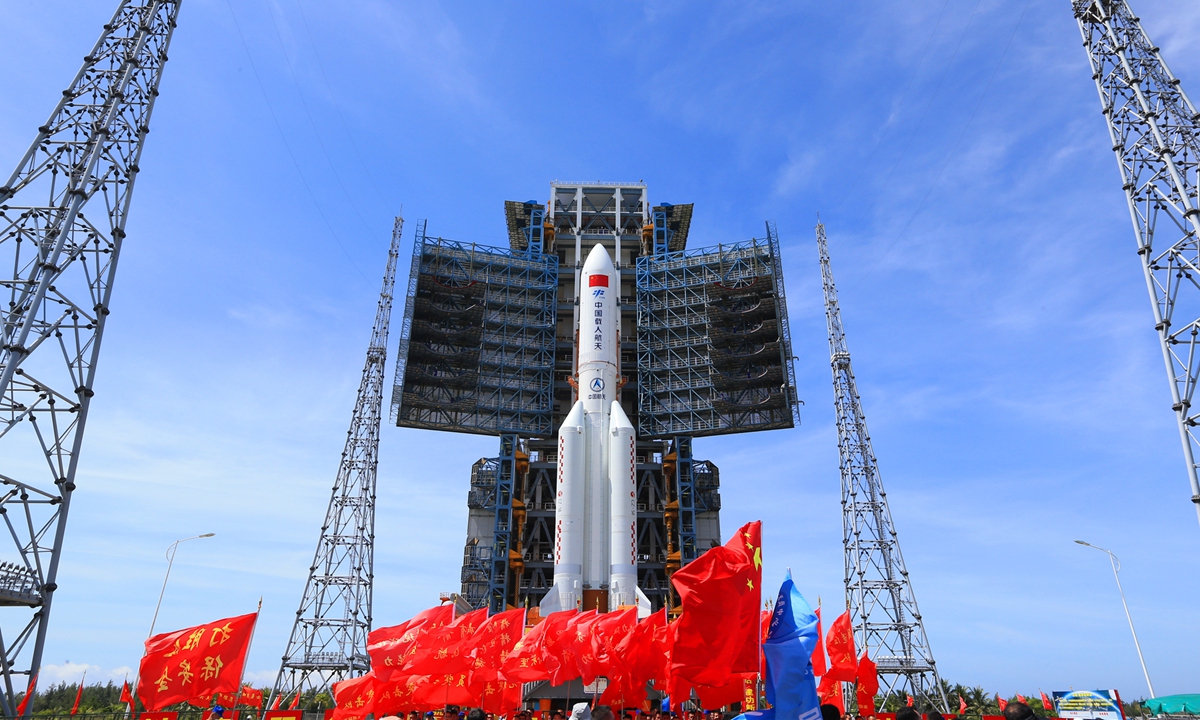
The combination of China's space station lab module Wentian and the Long March-5B Y3 carrier rocket has been transferred to the launch pad at the Wenchang space port on July 18, 2022. Photo: Tu Haichao and Huang Guochang
The combination of China's space station lab module Wentian and the Long March-5B Y3 carrier rocket has been transferred to a launch pad, the Global Times learned from the China Manned Space Agency (CMSA) on Monday, which revealed that it will be launched at an appropriate time in the near future.
A slew of pre-launch function checks and joint tests will be carried out in the following days, the CMSA noted. The logo for this launch mission has also been released on the same day.
"Judging by timetables of previous launches, Wentian's launch can be expected to happen in a few days from July 22 to 25," Wang Ya'nan, chief editor of Beijing-based Aerospace Knowledge magazine, told the Global Times on Monday.
To make room for Wentian's arrival, China's Tianzhou-3 cargo spacecraft, which was launched in September 2021, delivering six tons of goods to Tianhe, separated from the orbiting station on Sunday after completing all assigned tasks, according to the CMSA.
It is currently in good condition and will re-enter the Earth's atmosphere under ground control.
The Wentian lab module is equipped with the same taikonaut living facilities as the Tianhe core module, including three sleeping areas, a toilet and a kitchen. Together, Wentian and Tianhe can support six taikonauts living in space during the rotations of two spacecraft crews.
It also has an airlock through which taikonauts can exit, and a small robotic arm which can be used alone or combined with the large mechanical arm of the space station.
According to the China Aerospace Science and Technology Corp (CASC), after the space station combination receives the Wentian module, the Shenzhou-14 crew will enter Wentian to activate the life-support system, and complete the installation of scientific cabinets to enable them to carry out experiments in orbit.
Also, the Wentian module will host a new Tiangong Classroom lecture series and the taikonauts will, for the first time, use the airlock in the Wentian module to exit the station for extravehicular activities or spacewalk missions, the CASC disclosed to the Global Times.
The other lab module Mengtian is scheduled to be launched in October, said Hao Chun, director of the China Manned Space Agency.
Research fellows at the Chinese Academy of Sciences (CAS) said on Monday that the Xuntian telescope, or "Survey the Heavens," a space telescope research facility, is expected to be launched into orbit and fly with the space station in 2024 to carry out wide-area survey observations, the country's state media China Central Television reported.
At present, new progress has been made in the development of the initial prototype of the optical facility. The telescope is expected to be launched after the completion of the space station and will become the flagship astronomy facility to explore the starry sea, the report said.
The Xuntian telescope will be set up with an optical system with a diameter of two meters and equipped with a series of state-of-the-art probes. The size of the telescope is equivalent to a large bus, with the height about a three-story-tall building and weighing more than a dozen tons.
It will keep some distance but fly with the Tianhe space station in the same orbit. When it needs to resupply, Xuntian will dock with the space station. The instrument and system components onboard can be replaced or upgraded through the help of the taikonauts. Some components can also be transported to the lab modules for maintenance, Zhan Hu, a research fellow with the National Astronomical Observatories under CAS, told media.
According to the plan, the Xuntian telescope has a lifespan of 10 years, and can be prolonged under proper maintenance.




